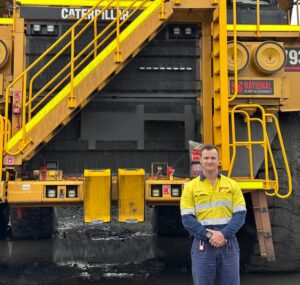The stage is set for economic recovery led by the mining industry

In June this year Mark Ackroyd, National Group Managing Director spoke about the impact the pandemic will have on the industry and how mining will help lead the charge and stimulate the economy as we come out the other end of the Coronavirus pandemic.
As Australia gets on top of the second wave of COVID-19, the stage is set for economic recovery led by the mining industry.
On 30 October, the Australian Bureau of Statistics released economic data that has confirmed the importance of the mining industry to the Australian economy.
Despite the overall economy contracting, mining industry GDP increased 4.9 per cent in 2019-20 which totalled $202 billion. This also made mining Australia’s largest industry with a 10.4 per cent share of the economy.
COVID-19 has changed the way businesses operate, but executives must now look beyond the pandemic to other global issues that will shape the industry beyond 2020.
What is now known as the 2020 stock market crash, also referred to as the Coronavirus Crash, was a major and sudden global stock market crash that began on 20 February 2020 and ended on 7 April. The crash was the fastest fall in global stock markets in financial history and the most devastating crash since the Wall Street Crash of 1929.
International stock markets such as the US based Dow Jones have since recovered by up to 35% at the time of writing from March lows. The USA however recently hit over 120,000 daily Coronavirus cases and with the ushering in of a new President, uncertainties remain on the speed of recovery the US economy will experience.
Ongoing tensions between the USA and China continue to play out, with Australia also experiencing tensions with China that could affect demand for commodities. The Australian mining industry relies heavily on exports to China and may need to diversify supply channels in order to deal with the potential for reduced demand.
Other factors that could impact future trade for Australia includes the recent Joe Biden win in the USA Elections, questions over how smooth the transition of power will be and the current social unrest the country is experiencing.
Europe is currently experiencing a second wave of Coronavirus, with countries like the UK breaking 20,000 new cases per day. The outcome of Brexit and the future trading relationship between the UK and the EU will also play a role as to how Australia could trade with Europe into the future.
Closer to home, Australian fiscal policies will also help shape the attractiveness of future investment in Australia. The 2020-21 Budget has committed additional support in response to the economic effects of the Coronavirus pandemic which will help stimulate the economy, but which will result in a larger deficit. Australia’s budget deficit hit almost $86 billion last financial year, the biggest blow to the bottom line since World War II. The deficit is projected to grow even further this financial year, with the Government forecasting a blowout of more than $184 billion in 2020-21.
On the 3 November, the Reserve Bank of Australia (RBA) cut the Cash Rate to an unprecedented record low of 0.1%. According to the RBA, this measure further supports job creation and the recovery of the Australian economy.
This Cash Rate cut will inevitably provide relief to the Australian public in order to aid with recovery following the pandemic, but will undoubtedly have an impact on future taxation rates, the value of the Australian Dollar, global trade due to exchange rates and the attractiveness of Australia to overseas investors.
The exchange rate is an important factor, with fluctuating exchange rates affecting the competitiveness of Australian imports and exports and the relative price of goods and services traded internationally. High interest rates in Australia are often coupled with a stable economy and commodities sector.
Encouragingly, recent economic data have been better than expected and the near-term outlook is better than it was three months ago. Even so, the recovery and outlook remains dependent on successful containment of the virus or a vaccine.
Falling commodity prices throughout the first half of 2020 have negatively affected the demand for the Australian Dollar and our commodities. In the third quarter of 2020 however, almost all commodity prices recovered following steep declines earlier in the year.
In August, Iron ore prices leapt to multi-year highs due to increased demand from Chinese. The price of Iron ore increased by 5.4% to $128.57 per tonne, the highest since 2014 and above the previous highs in early July 2019.
The price of gold hit an all-time high in early August, breaking the US$2,000 per troy ounce barrier. In times of uncertainty, investors have historically turned to gold as a safe haven during downturns, volatility or crisis. However, some analysts predict that gold’s rally is far from over.
In April, crude oil prices hit an all time low, moving into negative territory for the first time in history due to the pandemic and the oil price war between Saudi Arabia and Russia. Prices have since doubled, supported by sharp oil supply cuts by OPEC+, but prices remain one-third lower than pre-pandemic levels.
Looking ahead, oil prices are expected to gradually increase, with metals projected to see modest gains in 2021. The main risk to the price forecasts is the duration of the pandemic, including the risk of an intensifying second wave in the Northern Hemisphere and the speed at which a vaccine is developed and distributed.
The National Group continues to be a key supplier of mining equipment and supporting operations used in the extraction of commodities such as iron ore, gold and coal.
According to a study prepared by Wood & Mackenzie in November 2020 for the National Group, Australia is as a leading global commodity producer and is currently the largest exporter of metallurgical coal and iron ore and the largest producer of bauxite.
Iron ore prices increased significantly in the first half of 2020 due to strong Chinese demand in the and low supply volumes out of Brazil due to supply stoppages. Global seaborne iron ore supply is geographically concentrated to Brazil and Australia, together contributing 81% of seaborne exports in 2019. Brazil’s production has been disrupted in recent years however due to the tailings dam disasters in 2015 and 2019, followed by coronavirus shutdowns in 2020.
Import demand for metallurgical coal and iron ore is expected to grow over the next five years, with India leading demand growth for metallurgical coal while China leads import demand for iron ore.
Australia is expected to continue to dominate the global supply of metallurgical coal and iron ore, which is primarily driven by steel demand.
Iron ore is a key raw material necessary for the production of crude steel, with demand for steel driven by factors including urbanisation and industrial production, which is commonly used in the construction, machinery and automotive sectors. In 2019, this accounted for 57%, 17% and 12% of global steel consumption respectively.
Australia is the largest supplier of iron ore into the export market and had a 58% share of the global export market in 2019, the majority of which was delivered to China, Japan and South Korea.
Prices are expected to remain high through the remainder of 2020. Global seaborne demand for iron ore is expected to grow, with growth expected from Southeast Asia; particularly Vietnam and Indonesia. Despite its economic slowdown, China will continue to be the largest iron ore consuming nation for the foreseeable future.
Over the next decade, steel consumption is expected to grow, with increased demand from India and South east Asian countries, which is expected to drive continued growth in steelmaking capacity and therefore metallurgical coal demand.
With Australia ahead of the curve in regards to the Coronavirus pandemic and with mining industry now the biggest contributor to the growth of the economy as a whole, it’s time to turn our focus onto the longevity of the industry, prepare for future challenges and take advantage of emerging opportunities.



